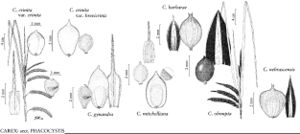Difference between revisions of "Carex gynandra"
Ann. Lyceum Nat. Hist. New York 1: 70. 1824.
FNA>Volume Importer |
FNA>Volume Importer |
(No difference)
| |
Revision as of 21:09, 16 December 2019
Plants cespitose. Culms acutely angled, 45–140 cm, scabrous. Leaves: basal sheaths red-brown or brown; sheaths of proximal leaves bladeless, scabrous, fronts red-brown to copper-brown, spots absent, indistinctly ladder-fibrillose; blades 12–55 cm × 4–10.5 mm. Inflorescences: peduncle of proximal spike 0.6–6.1 cm; proximal bract longer than inflorescence, 1.9–9.5 mm wide. Spikes 2–5 pistillate, 1–3 staminate, pendent; proximal pistillate spike 2.4–10.4 cm × 3–8.4 mm, base cuneate to acuminate. Pistillate scales pale brown to copper-brown, 3.1–8.2 mm (including awn), midvein reaching apex, apex of body acuminate or, rarely, truncate, awned. Perigynia ascending, pale brown, 0–5-veined abaxially, scarcely inflated, loosely enclosing achenes, ovoid to ellipsoid, 1.9–4.2 × 1.1–2.3 mm, dull, apex acute or obtuse, glabrous; beak 0.1–0.3 mm. Achenes variously constricted. 2n = 66, 68.
Phenology: Fruiting Jun–Aug.
Habitat: Swamps, floodplain forests, wet meadows, marshes, bogs, stream edges, margins of lakes and ponds, roadside ditches
Elevation: 0–2100 m
Distribution

St. Pierre and Miquelon, N.B., N.S., Nunavut, Ont., P.E.I., Que., Conn., Ga., Ky., Maine, Md., Mass., Mich., Minn., N.H., N.J., N.Y., N.C., Ohio, Pa., R.I., S.C., Tenn., Vt., Va., W.Va., Wis.
Discussion
Selected References
None.
